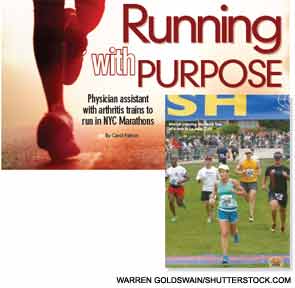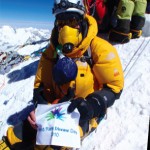
If you walk into Victoria A. Merrell’s beach bungalow, you may see one or two trophies sitting on the dresser, a mountain bike that’s covered with layers of dirt on her backyard patio, and a surfboard standing in the corner of the garage.
Merrell, PA-C, MPT, has been active in sports for as long as she can remember.
Soccer. Swimming. Cycling. Surfing. Mountain biking. Running. She enjoys them all, especially the last. While in her thirties, Merrell, who works for Roy Kaplan, MD, a rheumatologist in private practice in Encinitas, Calif., won her first triathlon in Monterey, Calif., and a second in Palo Alto, Calif., that involved a one-mile swim, 25-mile bike ride and a 10k (or six-mile) run.
But in the 1990s, she developed arthritis and was forced to place her athletic ambitions on hold for more than a decade. Under the care of a rheumatologist, Frank Dega, MD, she learned how to manage her disease, refusing to let it dictate her lifestyle. Four years ago, when the disease was under control, she started running again and hasn’t stopped. Today, at almost 50 years of age, she is currently training for the ING New York City marathon that will be held on Sunday, November 3, and raising money for the Arthritis Foundation.
“For me, running is kind of a meditation,” she says. “It’s a time I can think freely and decompress from the day.”
Uphill Battle
After moving from Idaho to California in the early 1990s, she started doing “easy beach runs,” then low-mileage runs, and slowly incorporated running and cross-training activities into a daily routine that was similar to her previous workouts before illness struck.
Merrell’s day typically begins at five o’clock in the morning. On weekdays, she runs six to eight miles. On weekends, she does her longer runs. When her legs are tired, she may swim, attend a spin class, go mountain biking, or even surf, just for fun.
Running every day can do more harm than good. “You end up overtraining,” she explains, “and it really sets you up for injury.”
Listen to more of our interview with Victoria Merrell.
Although she has had her fair share of common injuries, such as a stress fracture and plantar fasciitis, she has rarely missed a workout, which is based on a seven-minute, 35-second half-marathon pace. She adds variety to her training by changing the location of her runs and incorporating speed workouts, which involve intervals, like running up a hill 10 times or running 800 meters 10 times, each time at the same speed.
As the date of the marathon approaches, she plans on increasing the length of her run, building up to 20 or 22 miles. But several weeks before the race, she’ll cut back several miles to avoid unnecessarily stressing her body. If people can run 22 miles, she says, they can usually run 26 miles with success.
Merrell has no fantasies about winning the race. Her goal is much more realistic and achievable. “I’d be happy if I finished anywhere under four hours,” she says, adding that her sister will also compete in the same marathon.
Meanwhile, adopting proper nutrition and hydration habits is especially important. When running for relaxation, she explains that she doesn’t always need a fuel belt with water and other sports drinks like Gatorade, to replace fluids and electrolytes. But during training, when she is running harder and faster, hydration is critical.
“When on my long runs, I had to to teach myself to drink somewhere around eight to 10 ounces at a minimum every hour,” she says. “It’s also recommended to take some sort of fuel, whether it’s like GU or PowerBar gel packs.”
Into the Future
Years from now, Merrell still hopes to be running and competing in at least one special race each year. She has her heart and hopes set on destination marathons, like the Paris Marathon.
In the meantime, she says running helps her maintain balance in her life, both at work and home.
“It clears my head, allows me to focus on my work so I can be more effective in treating my patients,” she says, adding that she is now training her six-year-old son to enjoy sports, including surfing and mountain biking. “Since I encourage my patients to exercise, I like to practice what I preach.”
Merrell believes that running is much more about the overall positive experience, and much less about winning or losing.
“I wasn’t able to run for many years,” she says. “Now that my arthritis is under control, this is a big deal for me. “If you’re going to get into running, you have do it for your own enjoyment and set reasonable goals.”
Her race is already off to a great start. Consider that in 2012, more than 140,000 people completed applications for approximately 40,000 spots in the New York marathon. Since Merrell earned her right to compete and currently has the upper hand with her arthritis, many would believe that she has already crossed the finish line.
Carol Patton is writing the “After 5” series for The Rheumatologist.

